Waikeung Wong
FashionM3: Multimodal, Multitask, and Multiround Fashion Assistant based on Unified Vision-Language Model
Apr 24, 2025Abstract:Fashion styling and personalized recommendations are pivotal in modern retail, contributing substantial economic value in the fashion industry. With the advent of vision-language models (VLM), new opportunities have emerged to enhance retailing through natural language and visual interactions. This work proposes FashionM3, a multimodal, multitask, and multiround fashion assistant, built upon a VLM fine-tuned for fashion-specific tasks. It helps users discover satisfying outfits by offering multiple capabilities including personalized recommendation, alternative suggestion, product image generation, and virtual try-on simulation. Fine-tuned on the novel FashionRec dataset, comprising 331,124 multimodal dialogue samples across basic, personalized, and alternative recommendation tasks, FashionM3 delivers contextually personalized suggestions with iterative refinement through multiround interactions. Quantitative and qualitative evaluations, alongside user studies, demonstrate FashionM3's superior performance in recommendation effectiveness and practical value as a fashion assistant.
MVREC: A General Few-shot Defect Classification Model Using Multi-View Region-Context
Dec 22, 2024Abstract:Few-shot defect multi-classification (FSDMC) is an emerging trend in quality control within industrial manufacturing. However, current FSDMC research often lacks generalizability due to its focus on specific datasets. Additionally, defect classification heavily relies on contextual information within images, and existing methods fall short of effectively extracting this information. To address these challenges, we propose a general FSDMC framework called MVREC, which offers two primary advantages: (1) MVREC extracts general features for defect instances by incorporating the pre-trained AlphaCLIP model. (2) It utilizes a region-context framework to enhance defect features by leveraging mask region input and multi-view context augmentation. Furthermore, Few-shot Zip-Adapter(-F) classifiers within the model are introduced to cache the visual features of the support set and perform few-shot classification. We also introduce MVTec-FS, a new FSDMC benchmark based on MVTec AD, which includes 1228 defect images with instance-level mask annotations and 46 defect types. Extensive experiments conducted on MVTec-FS and four additional datasets demonstrate its effectiveness in general defect classification and its ability to incorporate contextual information to improve classification performance. Code: https://github.com/ShuaiLYU/MVREC
REB: Reducing Biases in Representation for Industrial Anomaly Detection
Aug 24, 2023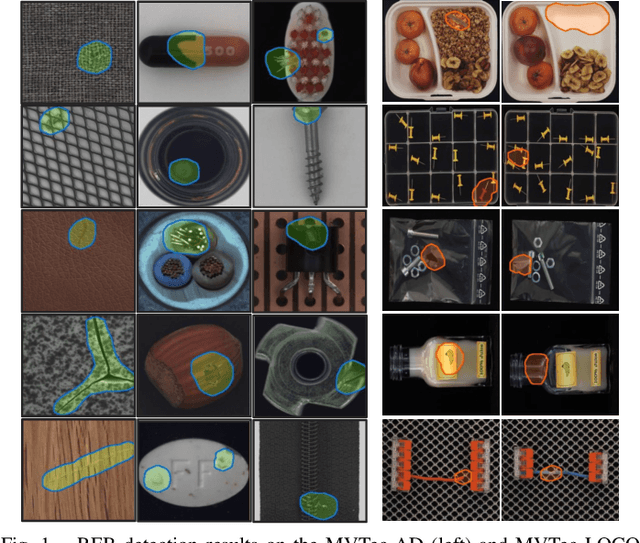
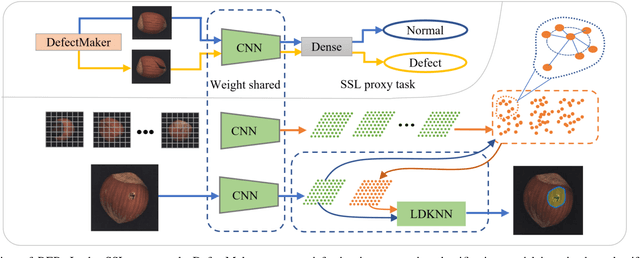
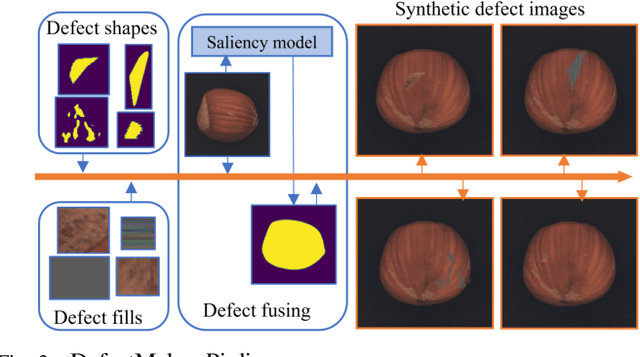
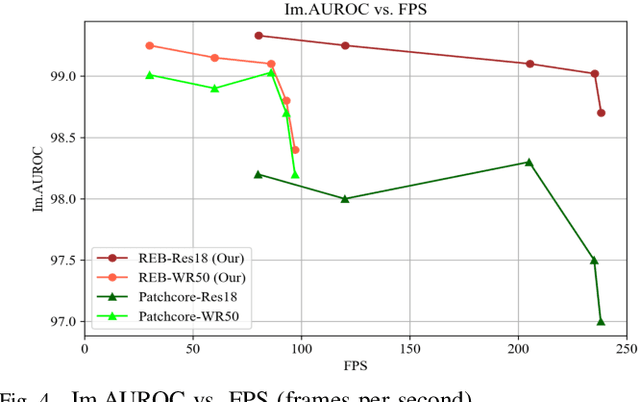
Abstract:Existing K-nearest neighbor (KNN) retrieval-based methods usually conduct industrial anomaly detection in two stages: obtain feature representations with a pre-trained CNN model and perform distance measures for defect detection. However, the features are not fully exploited as they ignore domain bias and the difference of local density in feature space, which limits the detection performance. In this paper, we propose Reducing Biases (REB) in representation by considering the domain bias of the pre-trained model and building a self-supervised learning task for better domain adaption with a defect generation strategy (DefectMaker) imitating the natural defects. Additionally, we propose a local density KNN (LDKNN) to reduce the local density bias and obtain effective anomaly detection. We achieve a promising result of 99.5\% AUROC on the widely used MVTec AD benchmark. We also achieve 88.0\% AUROC on the challenging MVTec LOCO AD dataset and bring an improvement of 4.7\% AUROC to the state-of-the-art result. All results are obtained with smaller backbone networks such as Vgg11 and Resnet18, which indicates the effectiveness and efficiency of REB for practical industrial applications.
Dress Well via Fashion Cognitive Learning
Aug 01, 2022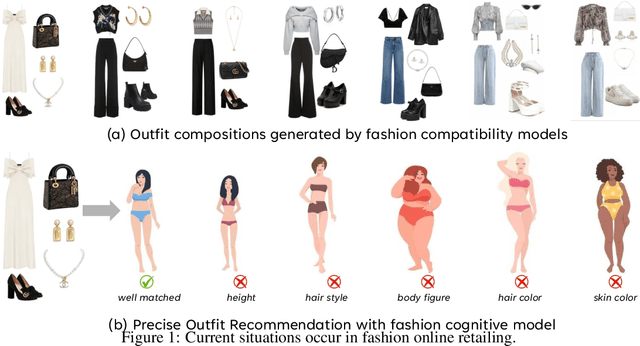
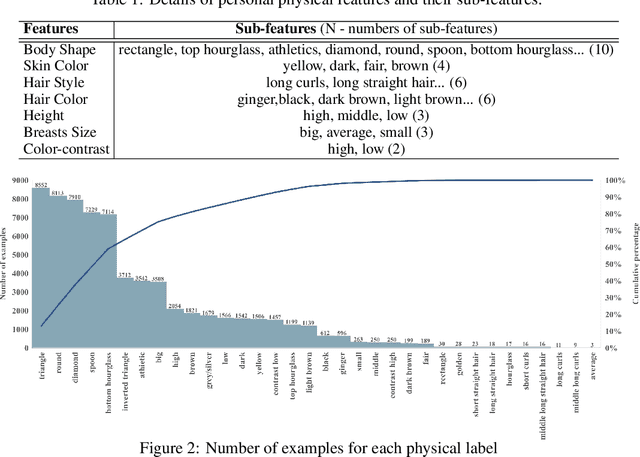
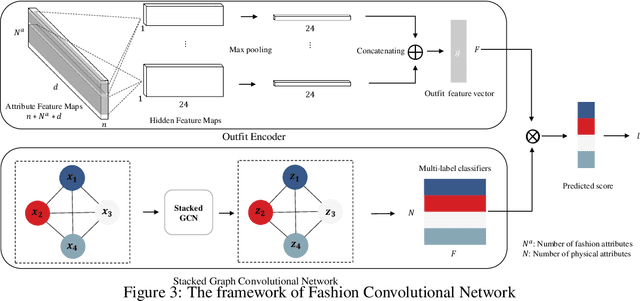
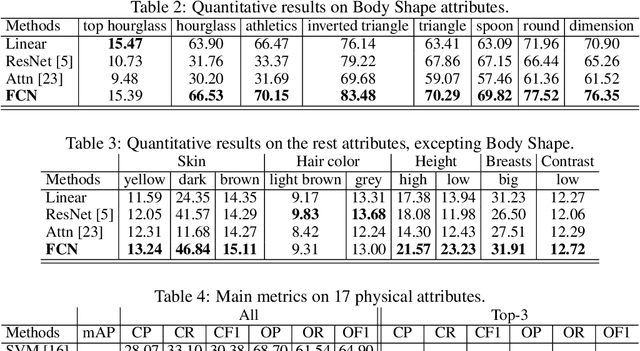
Abstract:Fashion compatibility models enable online retailers to easily obtain a large number of outfit compositions with good quality. However, effective fashion recommendation demands precise service for each customer with a deeper cognition of fashion. In this paper, we conduct the first study on fashion cognitive learning, which is fashion recommendations conditioned on personal physical information. To this end, we propose a Fashion Cognitive Network (FCN) to learn the relationships among visual-semantic embedding of outfit composition and appearance features of individuals. FCN contains two submodules, namely outfit encoder and Multi-label Graph Neural Network (ML-GCN). The outfit encoder uses a convolutional layer to encode an outfit into an outfit embedding. The latter module learns label classifiers via stacked GCN. We conducted extensive experiments on the newly collected O4U dataset, and the results provide strong qualitative and quantitative evidence that our framework outperforms alternative methods.
fAshIon after fashion: A Report of AI in Fashion
May 07, 2021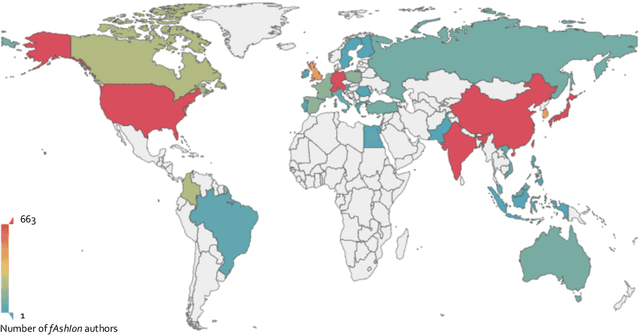



Abstract:In this independent report fAshIon after fashion, we examine the development of fAshIon (artificial intelligence (AI) in fashion) and explore its potentiality to become a major disruptor of the fashion industry in the near future. To do this, we investigate AI technologies used in the fashion industry through several lenses. We summarise fAshIon studies conducted over the past decade and categorise them into seven groups: Overview, Evaluation, Basic Tech, Selling, Styling, Design, and Buying. The datasets mentioned in fAshIon research have been consolidated on one GitHub page for ease of use. We analyse the authors' backgrounds and the geographic regions treated in these studies to determine the landscape of fAshIon research. The results of our analysis are presented with an aim to provide researchers with a holistic view of research in fAshIon. As part of our primary research, we also review a wide range of cases of applied fAshIon in the fashion industry and analyse their impact on the industry, markets and individuals. We also identify the challenges presented by fAshIon and suggest that these may form the basis for future research. We finally exhibit that many potential opportunities exist for the use of AI in fashion which can transform the fashion industry embedded with AI technologies and boost profits.
Regularizing Reasons for Outfit Evaluation with Gradient Penalty
Feb 02, 2020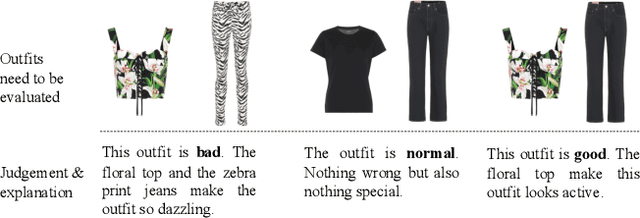

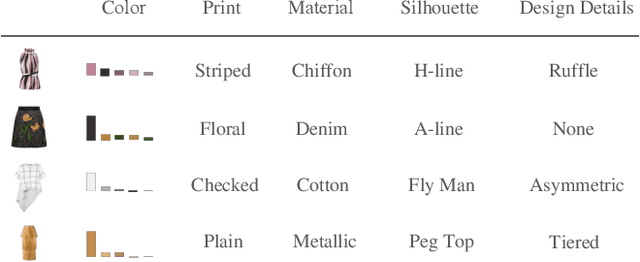
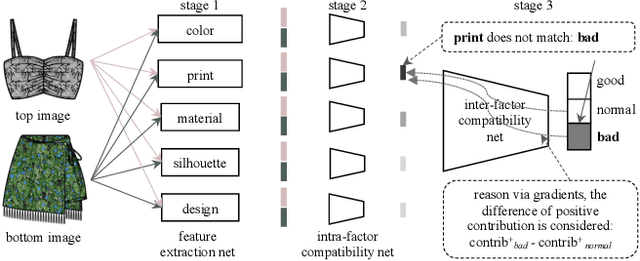
Abstract:In this paper, we build an outfit evaluation system which provides feedbacks consisting of a judgment with a convincing explanation. The system is trained in a supervised manner which faithfully follows the domain knowledge in fashion. We create the EVALUATION3 dataset which is annotated with judgment, the decisive reason for the judgment, and all corresponding attributes (e.g. print, silhouette, and material \etc.). In the training process, features of all attributes in an outfit are first extracted and then concatenated as the input for the intra-factor compatibility net. Then, the inter-factor compatibility net is used to compute the loss for judgment. We penalize the gradient of judgment loss of so that our Grad-CAM-like reason is regularized to be consistent with the labeled reason. In inference, according to the obtained information of judgment, reason, and attributes, a user-friendly explanation sentence is generated by the pre-defined templates. The experimental results show that the obtained network combines the advantages of high precision and good interpretation.
 Add to Chrome
Add to Chrome Add to Firefox
Add to Firefox Add to Edge
Add to Edge